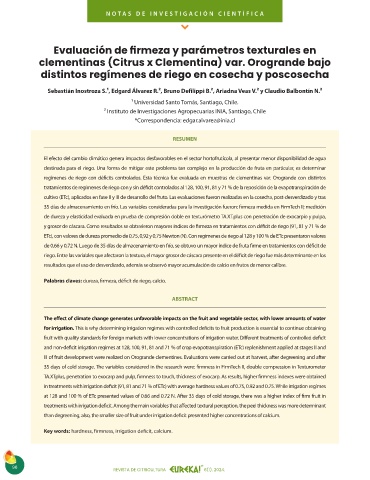Page 96 - Revista de Citricultura Eureka! Noviembre 2024
P. 96
NO T AS DE INVESTIGA CIÓN CIENTÍFIC A
Evaluación de firmeza y parámetros texturales en
clementinas (Citrus x Clementina) var. Orogrande bajo
distintos regímenes de riego en cosecha y poscosecha
Sebastián Inostroza S.1, Edgard Álvarez R.2, Bruno Defilippi B.2, Ariadna Veas V.2 y Claudio Balbontín N.2
1 Universidad Santo Tomás, Santiago, Chile.
2 Instituto de Investigaciones Agropecuarias INIA, Santiago, Chile
*Correspondencia: edgar.alvarez@inia.cl
RESUMEN
El efecto del cambio climático genera impactos desfavorables en el sector hortofrutícola, al presentar menor disponibilidad de agua
destinada para el riego. Una forma de mitigar este problema tan complejo en la producción de fruta en particular, es determinar
regímenes de riego con déficits controlados. Esta técnica fue evaluada en muestras de clementinas var. Orogrande con distintos
tratamientos de regímenes de riego con y sin déficit controlados al 128, 100, 91, 81 y 71 % de la reposición de la evapotranspiración de
cultivo (ETc), aplicados en fase II y III de desarrollo del fruto. Las evaluaciones fueron realizadas en la cosecha, post-desverdizado y tras
35 días de almacenamiento en frío. Las variables consideradas para la investigación fueron: firmeza medida en FirmTech II; medición
de dureza y elasticidad evaluada en prueba de compresión doble en texturómetro TA.XT.plus con penetración de exocarpio y pulpa,
y grosor de cáscara. Como resultados se obtuvieron mayores índices de firmeza en tratamientos con déficit de riego (91, 81 y 71 % de
ETc), con valores de dureza promedio de 0,75, 0,92 y 0,75 Newton (N). Con regímenes de riego al 128 y 100 % de ETc presentaron valores
de 0,66 y 0,72 N. Luego de 35 días de almacenamiento en frío, se obtuvo un mayor índice de fruta firme en tratamientos con déficit de
riego. Entre las variables que afectaron la textura, el mayor grosor de cáscara presente en el déficit de riego fue más determinante en los
resultados que el uso de desverdizado, además se observó mayor acumulación de calcio en frutos de menor calibre.
Palabras claves: dureza, firmeza, déficit de riego, calcio.
ABSTRACT
The effect of climate change generates unfavorable impacts on the fruit and vegetable sector, with lower amounts of water
for irrigation. This is why determining irrigation regimes with controlled deficits to fruit production is essential to continue obtaining
fruit with quality standards for foreign markets with lower concentrations of irrigation water. Different treatments of controlled deficit
and non-deficit irrigation regimes at 128, 100, 91, 81 and 71 % of crop evapotranspiration (ETc) replenishment applied at stages II and
III of fruit development were realized on Orogrande clementines. Evaluations were carried out at harvest, after degreening and after
35 days of cold storage. The variables considered in the research were: firmness in FirmTech II, double compression in Texturometer
TA.XTplus, penetration to exocarp and pulp, firmness to touch, thickness of exocarp. As results, higher firmness indexes were obtained
in treatments with irrigation deficit (91, 81 and 71 % of ETc) with average hardness values of 0.75, 0.92 and 0.75. While irrigation regimes
at 128 and 100 % of ETc presented values of 0.66 and 0.72 N. After 35 days of cold storage, there was a higher index of firm fruit in
treatments with irrigation deficit. Among the main variables that affected textural perception, the peel thickness was more determinant
than degreening, also, the smaller size of fruit under irrigation deficit presented higher concentrations of calcium.
Key words: hardness, firmness, irrigation deficit, calcium.
96
REVISTA DE CITRICULTURA 6(1). 2024.

